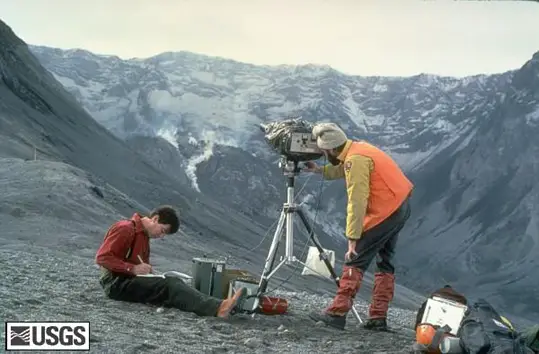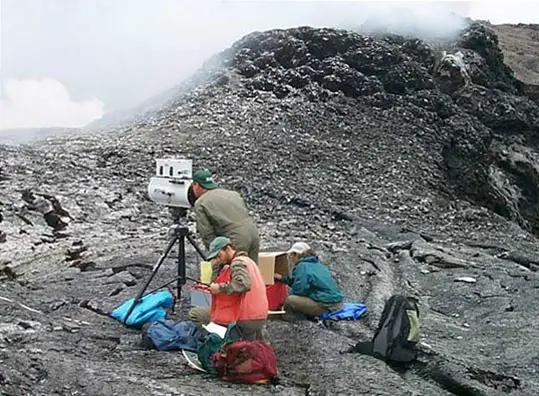Measuring Volcanic Emissions – Plumes
The rate at which a volcano releases gases into the atmosphere (usually reported in metric tonnes per day) is related to the volume of magma within its magma-reservoir system and its hydrothermal system. By measuring volcanic emissions, in particular changes of certain key gases like sulphur dioxide and carbon dioxide, scientists can infer changes that may be occurring in a volcano’s magma reservoir and hydrothermal system. The emission rates of sulphur dioxide and carbon dioxide are measured using airborne or ground-based techniques. During large explosive eruptions, sulphur dioxide gas injected high into the atmosphere is measured by an instrument aboard a satellite.
Correlation Spectrometer (COSPEC)
These instruments have been in use for more than twenty years and are used for measuring sulphur dioxide emission rates from various volcanoes around the world. They were originally designed for measuring industrial pollutants; the COSPEC measures the amount of ultraviolet light absorbed by sulphur dioxide molecules within a volcanic plume. The instrument is calibrated by comparing all measurements to a known SO2 standard mounted in the instrument. Although the COSPEC can be used from the ground in a vehicle or tripod (like that below) to scan a plume, the highest quality measurements are obtained by mounting a COSPEC in an aircraft and flying traverses underneath the plume at right angles to the direction of plume travel.

Infrared Carbon Dioxide Analyzer (LI-COR)
Use of a small infrared carbon dioxide analyzer (LI-COR) has recently become a standard method for measuring carbon dioxide emission rates at restless volcanoes. The LI-COR is mounted in a small aircraft configured for sampling outside air. Traverses measuring volcanic emissions are systematically flown through the plume at different elevations until the entire cross-section of the plume is analysed. From these data, a carbon dioxide emission rate can be calculated.
The following parts of the instrumentation are located inside the aircraft: LI-COR carbon dioxide analyzer and flow control unit (instruments in middle A), GPS receiver (left A), and laptop computer (right A) for running data-acquisition software. When the aircraft is over the target area, air and volcanic gases are sampled through a small tube (black tube beneath the COSPEC periscope, B). The air intake is located well upstream of an aircraft’s engine exhaust to avoid contamination.

Fourier Transform Infrared Spectrometer (FTIR)
Volcanoes emit gases both during and between eruptions, and measuring gas composition and flux is important in understanding magma dynamics and eruption style. The FTIR is capable of analysing several gases simultaneously using an open-path or closed-path system. The image below shows measuring emissions at Kilawea in Hawaii, and is employing the open-path method, which uses an optical telescope to aim the FTIR at a target gas some distance away. The infrared light source is either natural solar light or light from a heated filament behind the target gas. The closed-path method involves delivering gas from a plume or fumarole to a gas cell within the FTIR.

